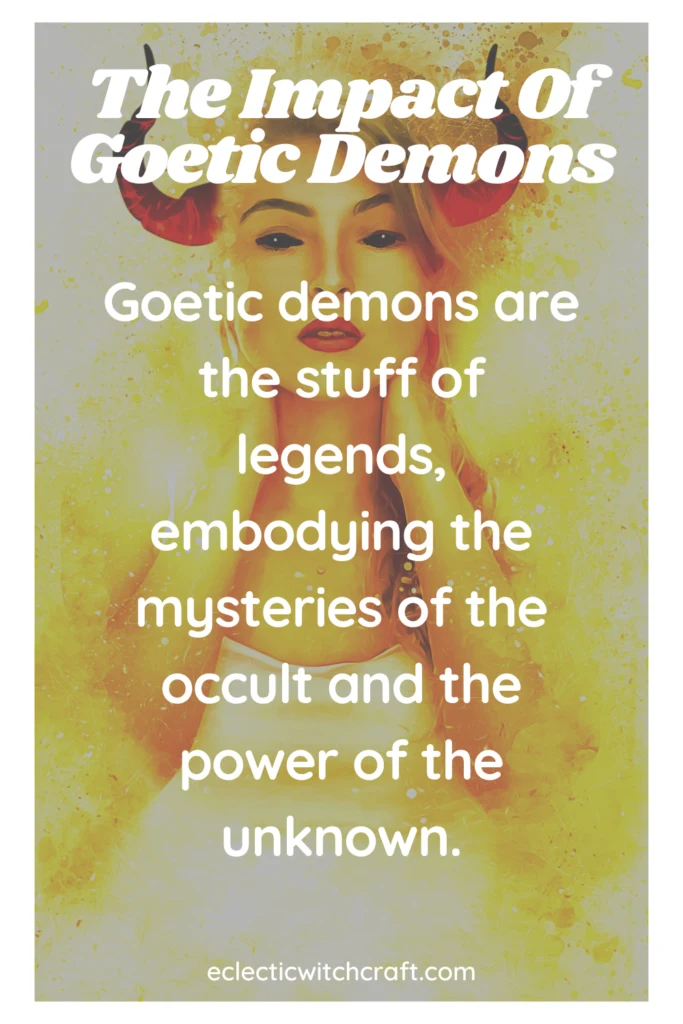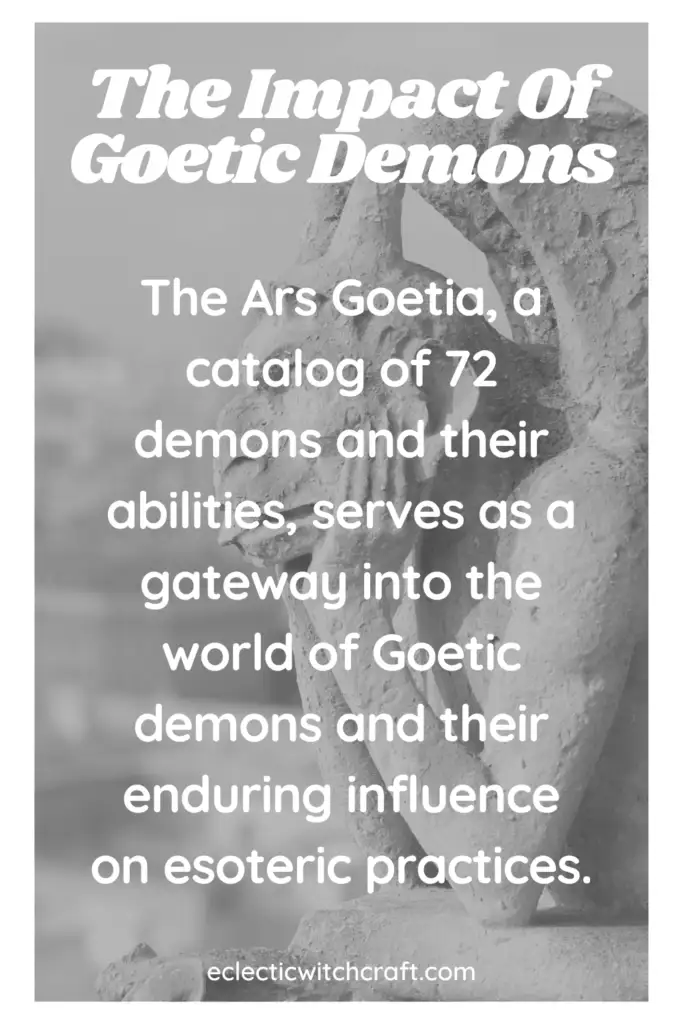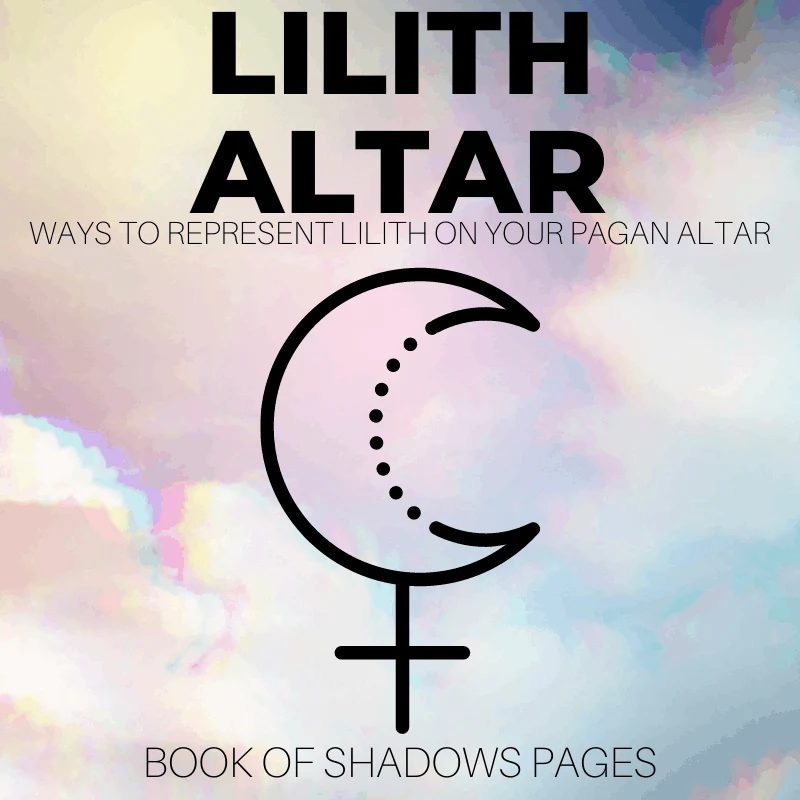Please note that posts on this site may contain affiliate links
Goetic demons have captivated the imagination of individuals for centuries, with their roots traced back to ancient Sumerian demonology. These demons are believed to possess immense power and knowledge, and have had a lasting impact on modern spirituality and religious beliefs.
The practice of summoning and communicating with Goetic demons has a rich history, dating back to the Middle Ages. One of the most notable texts on the subject is the Ars Goetia, a grimoire that catalogues 72 different demons and their powers. This section of the Lesser Key of Solomon, an anonymous 17th-century grimoire, describes each demon in detail, including its appearance, abilities, and functions.
According to the Ars Goetia, the 72 demons listed in the grimoire are divided into two hierarchies: the Kings who rule over 36 legions of spirits each, and the Dukes who command 10 legions each. Each demon has its own unique abilities, such as causing diseases or creating illusions, and is considered to be a powerful entity that can be summoned by magicians for various purposes.
However, it is important to exercise caution when dealing with these demons as they can be dangerous if not properly controlled. To counterbalance their influence, the 72 Angels of the Shem Hamephorash are believed to provide protection and serve as a balancing force.
History of Goetic Demons
The origins of Goetic demons can be traced back to ancient Sumerian demonology, where they were believed to be powerful spirits that could be summoned for knowledge and assistance. This belief in demonology was later adopted by the ancient Babylonians and Persians, and eventually found its way into Jewish and Christian beliefs.
Goetic demons have been a part of human history for thousands of years, with roots tracing back to ancient Sumerian demonology. The practice of summoning and communicating with these demons has evolved over time, with the most well-known text on the subject being the Ars Goetia.
The Ars Goetia has been a major influence on the practice of ceremonial magic, with its elaborate rituals and incantations being used to evoke the presence of these demons and work with their energies.
The use of Goetic demons in ritualistic practices has also been a part of neopagan forms of daemonolatry. In these traditions, these demons are seen as powerful spiritual forces that can be invoked and worked with for personal growth and transformation. The influence of the Ars Goetia has been felt throughout the history of esoteric thought, with many authors and practitioners exploring the ideas and techniques outlined in the grimoire.
Aleister Crowley, for example, sardonically positions the Goetia as a psychological exercise, suggesting that it can be used to explore human desires and powers, which are often seen as demonic or evil. This idea has been explored by many authors throughout history, with the Ars Goetia providing readers with an opportunity to explore their own inner darkness and gain insight into their own motivations and desires. Ultimately, the history of Goetic demons and the Ars Goetia is a rich and fascinating tapestry of human beliefs and practices, exploring the mysteries of the universe and the powers that exist within us all.
Historical accounts of Goetic demons can be found in various grimoires, such as the Ars Goetia, which lists the names and powers of 72 different demons. These demons were believed to be able to perform a variety of tasks, such as turning water into wine, and vice versa. Some of the most well-known Goetic demons include Astaroth, Baal, Stolas, Baphomet, Bune, Beelzebub, and Mammon.

Impact of Goetic Demons on Modern Spirituality and Religious Beliefs
The impact of Goetic demons on modern spirituality and religious beliefs is far-reaching and multifaceted. From influencing occult and esoteric practices to shaping contemporary beliefs in demons, the legacy of Goetic demons continues to be felt today.
Influence on Occult and Esoteric Practices
Goetic demons have been a prominent feature in the world of the occult and esoteric practices for centuries. These powerful entities have captured the imaginations of practitioners of high magic, ceremonial magic, Thelema, and neopagan forms of daemonolatry. Through the ages, the influence of Goetic demons has been felt in the realm of esoteric thought, inspiring a rich tradition of demon summoning and communication.
For many occult practitioners, the use of Goetic demons in magic is seen as a means of unlocking hidden knowledge and tapping into powerful energies. This has led to the development of a wide range of techniques and practices, including ceremonial magic which is centered around elaborate rituals, incantations, and visualizations to evoke the presence of these demons and work with their energies.
Similarly, neopagan forms of daemonolatry view these demons as powerful spiritual forces that can be invoked and harnessed for personal growth and transformation.
The legendary author and occultist Aleister Crowley was known to have a unique perspective on the role of Goetic demons in magic. He saw them as psychological exercises, a means of exploring human desires and powers often perceived as demonic or evil. This idea has been explored by many authors throughout history, including Christopher Marlowe, who wrote that “Hell hath no limits, nor is circumscribed in one self place, for where we are is hell, and where hell is must we ever be.”
Ultimately, the Goetia provides readers with an opportunity to delve into their own inner darkness and gain insight into their motivations and desires. Whether used for personal growth, spiritual transformation, or simply for the thrill of the arcane, the influence of Goetic demons will continue to be felt for generations to come.

Influence on New Age Movements
Goetic demons have had a significant impact on New Age movements and spirituality, with many practitioners incorporating the demons into their beliefs and practices. To some, the demons represent powerful sources of spiritual energy and guidance, and the use of their energies in rituals and magic is seen as a way to unlock hidden knowledge and tap into their power.
One of the reasons for the popularity of Goetic demons in New Age movements is the belief that they can help individuals connect with their own inner power and spiritual abilities. Some practitioners see the demons as guides who can provide insight and wisdom, and help individuals to unlock their full potential.
The use of Goetic demons in New Age rituals and magic is often seen as a way to tap into their powerful energies, and to harness those energies for personal growth and transformation. Practitioners may use incantations, meditations, and other spiritual practices to invoke the energies of these demons and to bring their power into their own lives.
Another reason for the popularity of Goetic demons in New Age movements is their association with the occult and esoteric traditions. Many practitioners see these demons as powerful and mysterious forces that can provide access to hidden knowledge and secret wisdom. They may explore the lore and legends surrounding the demons, and may seek to understand their powers and abilities in order to harness them for personal growth and transformation.
In addition, the use of Goetic demons in New Age practices is often seen as a way to connect with ancient spiritual traditions and to tap into the wisdom and power of these traditions. Practitioners may explore the history of demonology and the role that these demons have played in various spiritual and religious traditions, and may seek to incorporate those traditions into their own spiritual practices.
Influence on Christianity
Goetic demons have had a lasting impact on Christianity, rooted in both Hebrew and Greek cultures. The early Christian understanding of demons was heavily influenced by the New Testament, where Christ’s exorcisms of demons and gift of that power to his disciples were emphasized. The demons were seen as fallen angels with Satan as their leader, and represented a significant moral challenge for Christians.
The Ars Goetia specifically is a product of Solomonic ceremonial magic, an Abrahamic system of magic that calls upon God and uses holy names to command the demons. The demons listed in the Goetia come from a tradition of Christian demonology and many of them are also listed in the Pseudomonarchia Daemonium, a 16th century book on demonology by Johann Weyer.
While the stereotype of Satanists summoning demons is often portrayed in popular culture, the reality is that all texts on summoning demons from this time period were distinctly Christian. This does not mean that non-Abrahamic practitioners cannot work with the Goetia, but it is important to be cautious and use methods of protection that are comfortable.
It is also worth noting that some of the demons listed in the Goetia have roots in older Jewish lore, such as demonized Canaanite gods, while others have origins in Zoroastrian mythology and made their way into Jewish apocryphal texts. The influence of Goetic demons on Christianity is thus a complex mixture of religious, cultural, and historical elements.

Influence on Islam
In Islam, King Solomon is regarded as one of the prophets of God who was gifted with the ability to communicate with both animals and jinn, including enslaving the shayāṭīn (devils) and dīv (demons) with the support of a staff or ring given to him by God. Islamic folklore expands on the legends of Solomon and his jinn, making him the archetype for esoteric traditions surrounding the binding and control of these entities.
According to orthodox accounts, Solomon was granted wisdom and mastery over the jinn, with the angel Jibrail driving hosts of jinn to swear fealty to the prophet. The jinn came to Solomon in various forms, including some with multiple heads, wings, talons, tails, and even a tribe of insect-like jinn. In another tradition, Solomon learned the names of the jinn from one of their kings, Fqts, and used the Seal of Solomon, a divinely-granted ring, to rule over 70 or 72 jinn who served him as soldiers, builders, and messengers.
It is said that Solomon taught his vizier and scribe, Asif, wisdom, and with his knowledge of God’s Names and the Secret Letters, as well as his mastery of the jinn, Asif was able to bring the Queen of Sheba to Solomon in the blink of an eye. However, not all the jinn were obedient and King Solomon punished those who rebelled by binding them in metal vessels and stone pillars, which contain trapped jinn until they are released by the unwise.
One of the rebelling jinn was a ten-headed monster bound by King Solomon and the Queen of Sheba under Aden in Yemen. This jinn was an ifrit who was known for ambushing travelers and challenging them to poetry competitions. Another rebellious jinn, Habiqiq, managed to steal the ring of Solomon, posing as the king and ruling for several days before being forced to flee and dropping the ring. The ring was swallowed by a fish and returned to Solomon when he bought and ate it, restoring his power and punishing the rebellious jinn by locking him in a chest and tossing it into the ocean.
Several ancient sites, including Palmyra, Aden, and Ghumdan Palace, are associated with the jinn who built Solomon’s temple and palace. The stories of King Solomon and his mastery over the jinn continue to be a significant aspect of Islamic folklore and beliefs, shaping the understanding and interpretation of these entities in the Islamic tradition.
Uses in Rituals and Magic
Goetic demons have also played a role in various rituals and forms of magic, with practitioners summoning these demons to perform tasks or gain access to hidden knowledge. The use of incantations, evocation, and possession are all commonly associated with the practice of summoning and communicating with Goetic demons.
Conclusion
In conclusion, the impact of Goetic demons on modern spirituality and religious beliefs is far-reaching and multifaceted. From influencing occult and esoteric practices to shaping contemporary beliefs in demons, the legacy of Goetic demons continues to be felt today. Whether viewed as powerful sources of knowledge and guidance, or as dangerous and malevolent entities, the fascination with these demons continues to endure. Whether you are an academic with a curiosity in demonology, or an occultist seeking to add to your library of knowledge, the study of Goetic demons is a fascinating and thought-provoking subject.
Represent the dark goddess Lilith on your altar.
This is a simplified PDF, made for easy printing. It's perfect to add to your book of shadows.


